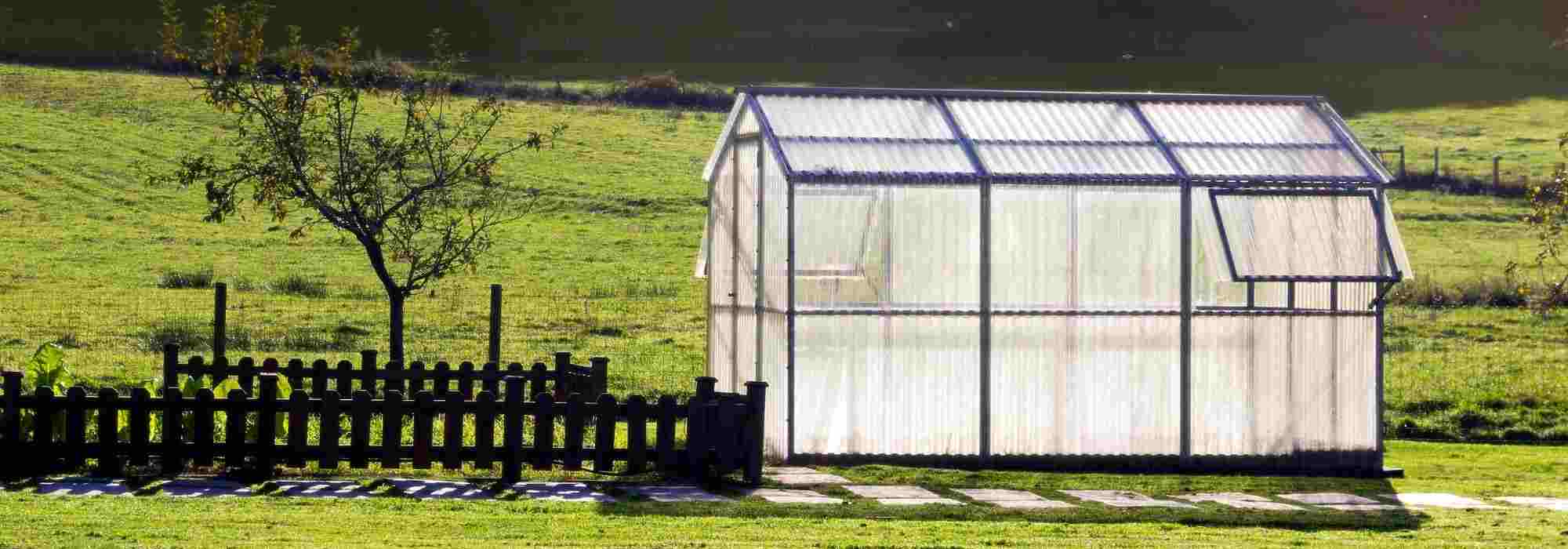
How to choose a greenhouse?
Our tips to find the ideal model
Contents
In the garden, the question of investing in a greenhouse often arises. This term encompasses several types of installations that create a microclimate in an enclosed space, allowing for the cultivation and protection of plants.
The advantages of having a greenhouse in the garden are indeed well established: anticipation of sowing, protection for tender plants or those sensitive to diseases, a place for storage, wintering, and gardening in a sheltered environment. The greenhouse allows for an extended growing season while increasing productivity.
However, it is not always easy to navigate among the different models of greenhouses available, as prices can vary significantly depending on the dimensions and materials chosen.
From the mini greenhouse to the wind-resistant glass greenhouse, as well as the tunnel greenhouse and the polycarbonate greenhouse, let’s explore how to choose the right garden greenhouse for you.
Choosing a greenhouse based on its use
The central criterion for choosing a greenhouse is based on your needs and the primary role it should play: what use(s) do you intend for your garden greenhouse? From a simple small greenhouse for sowing to a large greenhouse for growing tender tropical plants, you will surely find a model suited to your type of use.
For sowing and cuttings: the mini-greenhouse
For gardeners looking to optimise and succeed in their sowing and plant propagation, but with very limited space, mini-greenhouses are ideal.
On a balcony or in a living room, they create the optimal microclimate to encourage germination, seedling growth, or cutting development.
They help prevent humidity stagnation with ventilation systems, mitigate damping-off in seedlings, and improve protection for young plants against pests and diseases.
This model is also perfect for beginner gardeners who want to embark on their first crops through sowing or propagation by cuttings.
The smallest and lowest mini-greenhouses will be reserved for the early growth stages of seedlings, while the larger ones are more suited for cuttings.
To learn more, check our advice sheet: Mini-greenhouse: what is it for? How to use it?
For vegetable gardens and market gardening: the tunnel greenhouse or frame greenhouse
Tunnel greenhouses or market gardening greenhouses are particularly used for growing vegetables. They allow for an earlier start to the season than in open ground, providing protection against wind and weather, which can gain a few precious degrees in temperature. Similarly, in winter, temperatures can rise quickly as soon as a ray of sunshine hits their structure.
The tunnel greenhouse is ideal for growing non-hardy vegetable plants and can even be used for overwintering some tender subjects.
They adapt to all gardens and available spaces as they offer a wide range of models with customisable sizes.
For overwintering and great versatility: traditional greenhouses
Traditional greenhouses or polycarbonate or glass growing greenhouses resemble small houses. They are the most versatile: they allow for early sowing, plant propagation, vegetable cultivation, or protection for non-hardy subjects in winter.
They can accommodate both potted plants and climbing plants and also allow for ground-level cultivation. They can even serve as a true winter garden.
 Mini-greenhouse, tunnel greenhouse, and traditional greenhouse.
Mini-greenhouse, tunnel greenhouse, and traditional greenhouse.
Cold greenhouse or warm greenhouse?
The insulation of the greenhouse obviously affects its ability to maintain heat and positive temperatures during the cold season. The better insulated a greenhouse is, the less the plants will be exposed to low temperatures and thermal shocks.
When combined with a heating system, the greenhouse will allow for the cultivation of the most heat-demanding plants, even in regions with harsh winters.
- The cold greenhouse protects crops from the elements, but its temperature can drop below 0°C during the cold season, as it is not heated.
- The temperate greenhouse is a zone that is always kept frost-free thanks to a heating system. Generally, the temperature does not drop below 5°C. It is ideal for overwintering less hardy plants that are sensitive to negative temperatures.
- The warm greenhouse is a heated tropical greenhouse that maintains a constant temperature of around fifteen degrees during winter. It allows for the development of demanding exotic plants that cannot tolerate temperatures below ten degrees.
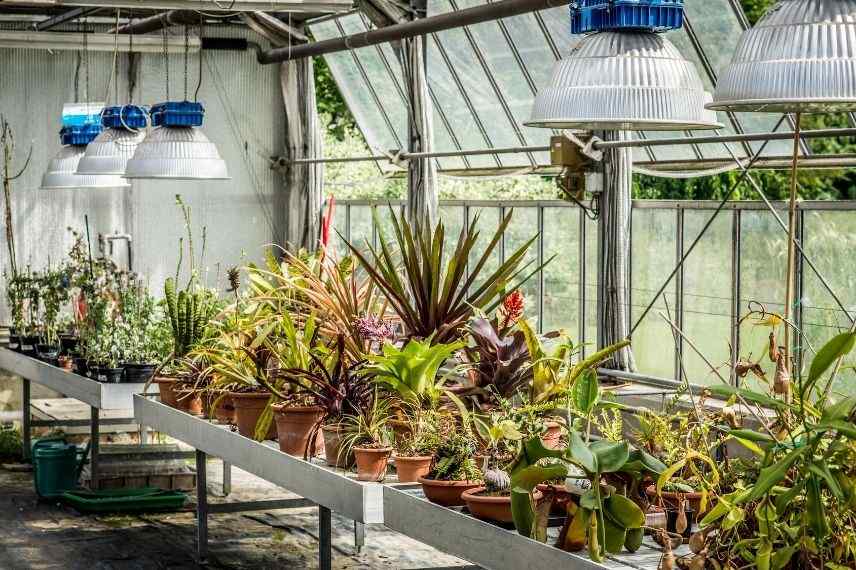 Heated greenhouse for tropical plants
Heated greenhouse for tropical plants
What is the ideal size for a greenhouse?
Here again, the choice of greenhouse size will depend on the available space, the intended use, and, of course, your budget. The greenhouse will be smaller if you only plan to grow during the fine season or as a hobby, but it will need to be larger for year-round gardening or to achieve a certain level of food self-sufficiency.
The size of the greenhouse can be calculated based on the area of your vegetable garden. In professional market gardening, farmers estimate that the area covered by the greenhouse should represent at least 10% of the total cultivated area.
Don’t overlook the circulation spaces, to allow for easy movement.
To get started, a greenhouse of 4m2 (2 metres by 2 metres) is already sufficient to launch several crops. For more space and to winter sensitive plants, opt for a model with at least double the area.
From around ten square metres, tunnel greenhouses often prove to be the most sought-after models due to their reasonable size-to-price ratio.
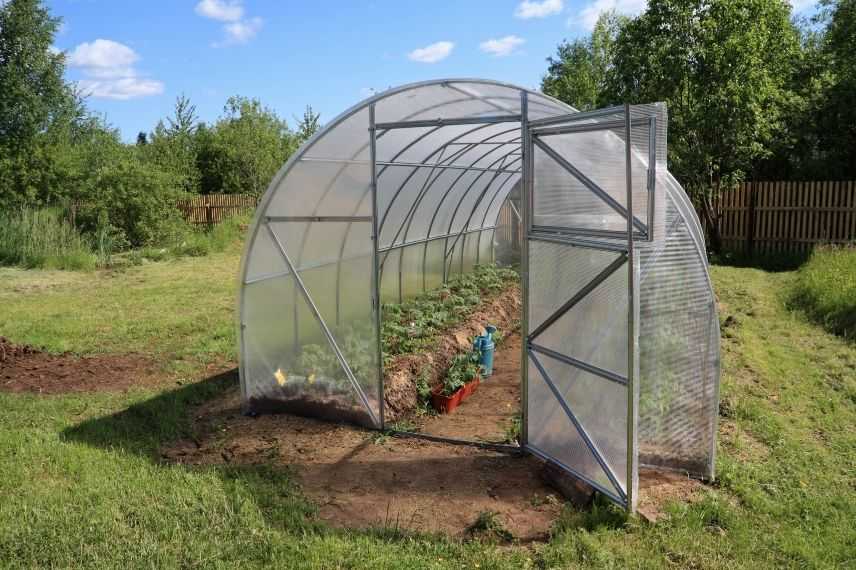
The tunnel greenhouse is a classic!
Choosing the right materials for your greenhouse
The quality of the structure and materials is a key criterion that defines the price of a greenhouse. It ensures good insulation, strength, and longevity of the greenhouse.
The structure of the greenhouse
- PVC: more affordable to purchase and lightweight, PVC structures are generally reserved for entry-level greenhouses or small greenhouses, as they tend to be more fragile and less durable.
- Wood: greenhouses with wooden structures combine aesthetics and durability. However, wood requires regular maintenance to prevent degradation and is much bulkier, limiting light diffusion. Opt for treated woods, previously protected against parasitic and weather damage.
- Steel: it offers good resistance and longevity. Choose a minimum thickness of 3mm and galvanised steel, designed to resist oxidation.
- Aluminium: it provides better insulation and greater durability while being lightweight and thin, allowing maximum light to pass through. It is the highest quality material, but also the most expensive.
The walls of the greenhouse
- Polyethylene: less durable (approximately 3 years), it loses effectiveness over time by becoming opaque and deteriorating. Opt for UV-resistant covers, double-layered or with a minimum thickness of 200 g/m².
- Polycarbonate: a lightweight material with a good lifespan (approximately 5 to 10 years) that blocks harmful UV rays. For good insulation, choose a thickness greater than 4mm.
- Glass: more expensive, but the best insulator and the material with the longest lifespan (several decades). Opt for horticultural glass (cheaper but more fragile) or toughened glass (more expensive but weather-resistant and safer).
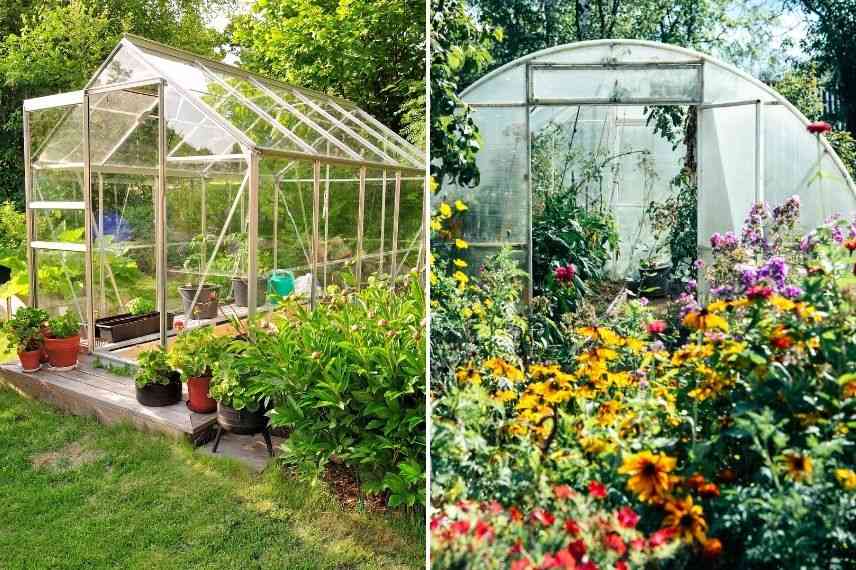
Glass greenhouse and plastic greenhouse.
Criteria not to overlook
The dedicated location
It allows for determining the dimensions of the greenhouse in advance. It is worth noting that a greenhouse should ideally be placed in full sun, in an open area away from trees, walls, and other buildings, but installed sheltered from prevailing winds.
The legislation
It concerns the installation of external structures in your garden. No procedures (prior declaration of works or building permit application) are necessary as long as the greenhouse does not exceed 1.8 metres in height and 5m² in ground area.
In case of doubt or in more restrictive protected areas, do not hesitate to consult the PLU (Local Urban Planning Plan) of your municipality.
The anchoring
It ensures the proper maintenance and stability of the greenhouse while protecting it from stagnant water. Installing a base allows for good anchoring in the soil without the need to create foundations. The greenhouse must also be wind-resistant!
Plan to add anchoring stakes or concrete blocks for heavy and/or large greenhouses.
Ventilation and openings
Doors, gables, skylights,… They help promote air circulation, limit extreme temperatures, prevent diseases, and preserve soil life.
The size of the main opening should also be chosen according to the dimensions of the plants to be grown and the equipment that will be stored in the greenhouse.
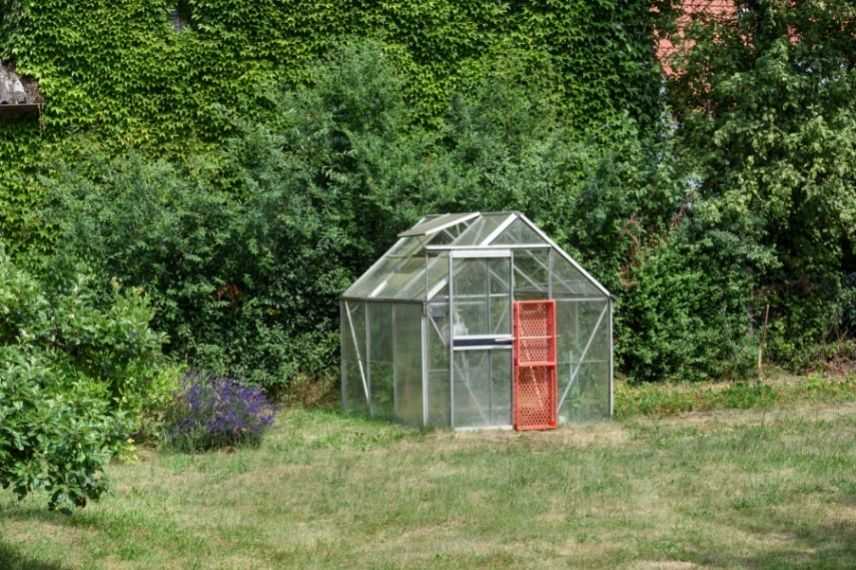
Greenhouse oriented towards full sun, sheltered from the wind and equipped with windows for good ventilation.
Advantages and disadvantages of each type of greenhouse
Mini-greenhouses
Equipped with a short stem of bulb or alveolate plates, they allow for direct placement of potting soil or several small growing pots.
Pros:
- practical
- compact and ideal for small spaces
- reusable
- inexpensive
Cons:
- very limited use
Tunnel greenhouses
Tunnel greenhouses consist of a frame and a plastic covering. They come in all price ranges, varying from a few dozen euros per square metre to over €150 per square metre, depending on the size and quality of materials (frame and cover).
Pros:
- easy and quick to assemble
- movable structure
- good size-to-price ratio
- quality structures can be quite durable
Cons:
- limited lifespan if made from low-quality materials
- more fragile
- lack of stability, limited resistance to weather
- insufficient insulation in winter
- questionable aesthetics
To further extend the lifespan of your tunnel greenhouse, you can opt for seasonal use. The structure can then be dismantled during the cold season and reassembled the following season.
Polycarbonate greenhouses
Polycarbonate greenhouses offer a compromise in terms of price: they are cheaper than glass greenhouses but more versatile, insulating, and aesthetically pleasing than tunnel greenhouses. Again, the price range depends on the choice of materials: from €50 per square metre to several hundred euros per square metre depending on the thickness in millimetres.
Pros:
- great versatility
- durability of several years
- good insulation
- UV protection
Cons:
- more complicated assembly
- fixed structure, which can be difficult to move
- gradual aging of panels (loss of transparency, darkening, etc.)
- fragility if materials are too light (weather, storms, strong sunlight, etc.)
For better weather resistance, consider placing your greenhouse in a sheltered area from prevailing winds and securing it well to the ground.
Glass greenhouses
Glass greenhouses are the highest quality greenhouses, but they represent a long-term investment, often costing several thousand euros.
Pros:
- great versatility
- durability of several decades
- best insulation
- high light transmission and even heat distribution
- strength and resistance to severe weather
- aesthetics
Cons:
- expensive
- more tedious installation
- shading necessary in summer in the hottest regions
- fixed structure, which cannot be moved
Recycled greenhouses
Finally, it is entirely possible to build your own greenhouse using recycled materials (tarpaulin, old windows, straw, etc.).
Pros:
- cost-effective
- eco-friendly
- customised and unique greenhouse, tailored to the gardener’s needs
Cons:
- limited insulation
- variable durability
- aesthetics
- Subscribe!
- Contents
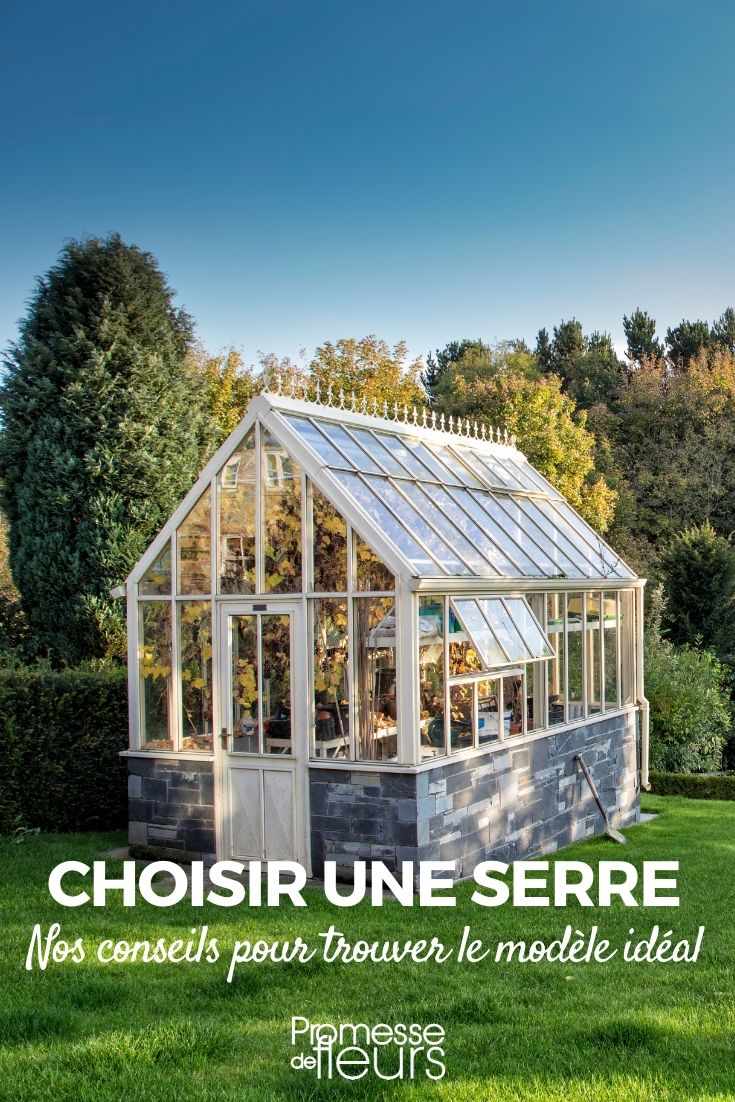































Comments